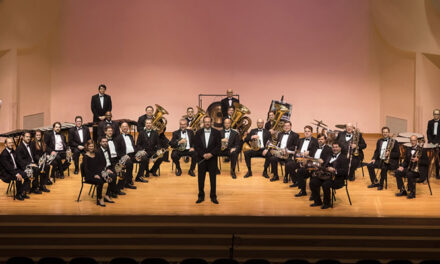The program presented under the auspices of the Raleigh Area Flute Association at the Carswell Recital Hall of Meredith College was quite out of the ordinary – an entire concert of music for unaccompanied flute, and contemporary music at that. Soloist was Mary Jo White, professor of flute at UNC Wilmington, a native North Carolinian who took her doctorate in flute with Doriot Anthony Dwyer at Boston University, and the featured composer was Benjamin Boone, another Carolina native, now on the faculty of California State University Fresno. Boone, a charming presence on the stage, introduced each of the works with considerable detail about their origins and inspirations.
First up was A Tribute to Debussy’s Syrinx, a work dating back to the composer’s days as a student at Boston University (1989), and the uninformed listener would certainly never make a connection between this piece in an advanced idiom and the immediately memorable work for solo flute that served as its model. Not only does the composition not cite the model, but there is not the remotest hint of French perfume here.
That being said, one could tell from the outset that Boone has a knack for writing for the instrument (he revealed in his introductory remarks that not only had he studied flute as an undergrad, but had a major crush on his teacher). The second of the work’s two movements (titled “Pandemonium”) was a virtual catalog of possible effects, with registral contrast between high and low, flutter-tongue, slap-tongue, multiphonics, and bending, all integrated into a comprehensible structure based on a standard flute sound.
The second work, Rafflesia [2003] was commissioned by a colleague at Fresno, and based on the image of the immense Malaysian rainflower blossom named for the noted British imperialist Sir Stamford Raffles, leader of the expedition on which it was discovered, and the founder of Singapore. Particularly successful here was the closing “Blossom Dance,” which for this ear evoked the music of the Balkans, with dancing, irregular rhythms and a modal character.
The final work, Nature’s Song, commissioned in 2008 by White, was to have been based on Native American music from North Carolina, but with the exception of the fourth movement (a “Cherokee Shaman’s Call”), was built around birdsong. Boone played field recordings of the sources, and then we could enjoy hearing his composerly transformations of nature.
White showed herself a past master of the technique and techniques needed to bring these difficult but appealing works to life. She plays with a large tone, largely free of vibrato, and is completely at ease in the lowest and very highest ranges of the instrument. Her temperament perhaps inclines more toward the virtuosic than to the enticingly cantabile – what this ear was most impressed with was her articulation of rhythm, rather than simply beauty of tone and line. Boone’s works, along with other selections, have been recorded on White’s newly issued CD. No distribution as yet, but it will probably be available through fluteworld.com and other sources.
The turnout for the concert was small, and the number of non-flutists present could probably be counted on the fingers of one hand. Boone and White deserved a larger throng for an engaging and enjoyable program.











